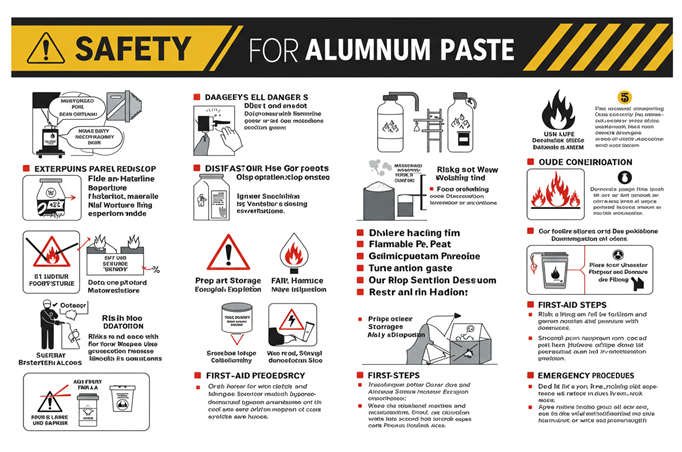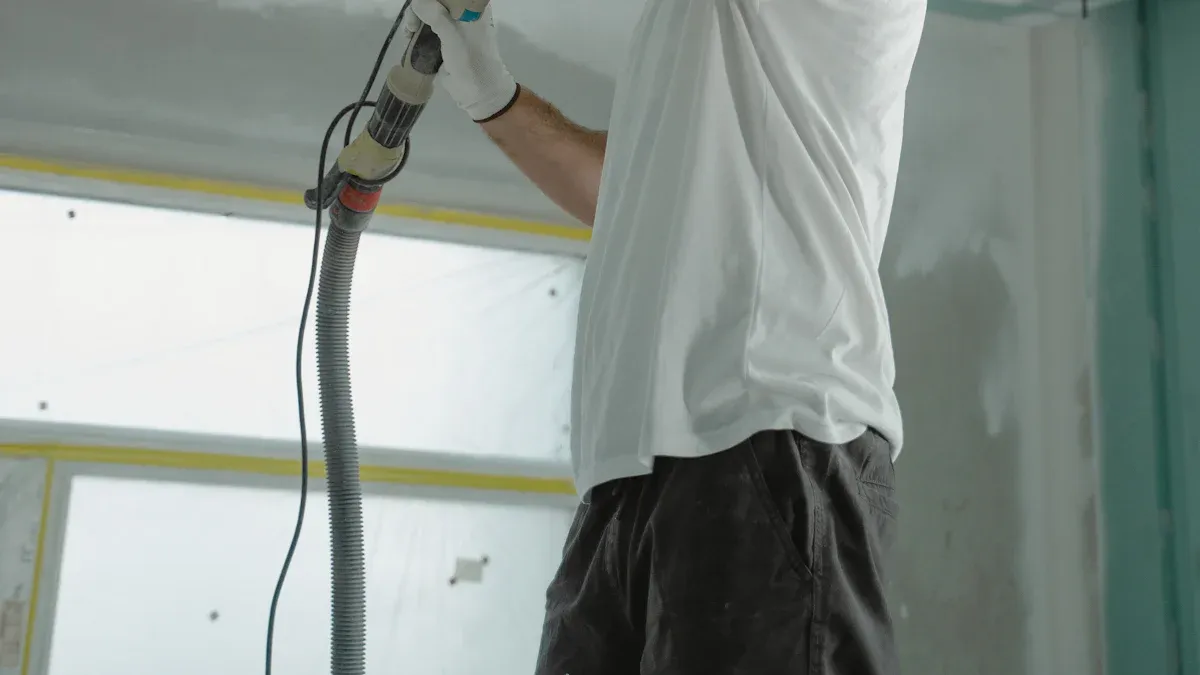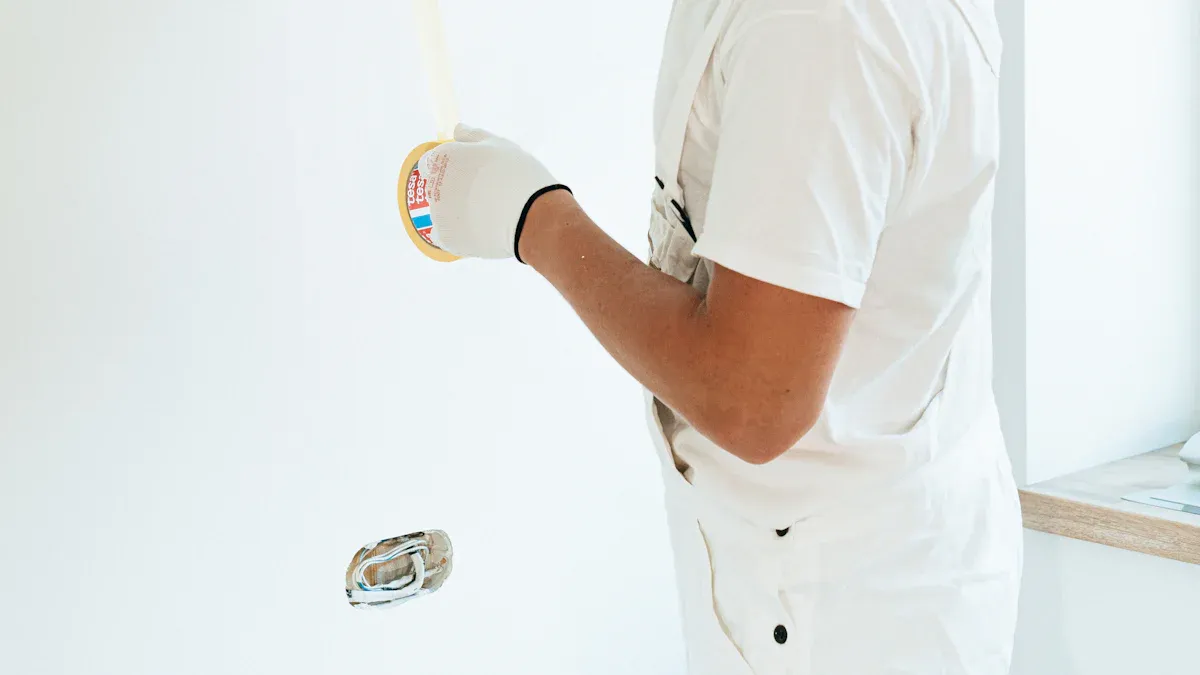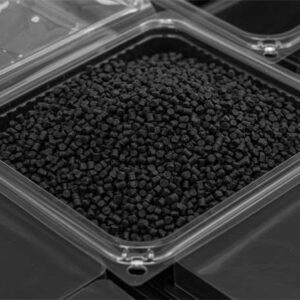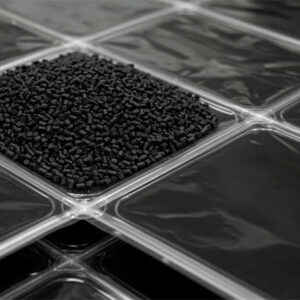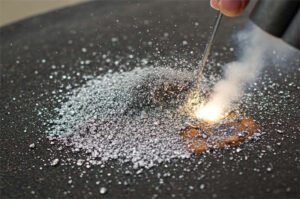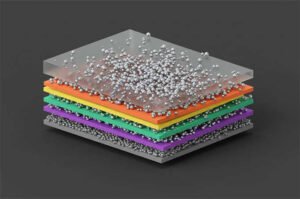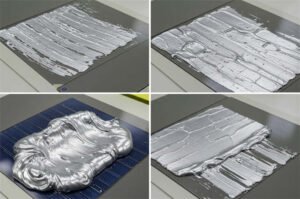Working with aluminum paste means you must think about Safety Considerations. There are risks like fire from flammable solvents. You can have breathing problems from aluminum flakes. Your skin might get irritated. The table below shows aluminum paste needs more protection than other metal pastes. Always read the MSDS and follow all safety rules.
| Safety Aspect | Aluminum Paste Specifics | Other Metal Pastes (e.g., Thermal Pastes) |
|---|---|---|
| Respiratory Protection | You need NIOSH-certified respirators (N95 or PAPR). This is because you can breathe in aluminum flakes and solvents. | Usually, you do not need special respiratory protection. |
| Skin Contact | Wear protective clothing. There is a risk of dry skin, irritation, and rare allergies. Wash your skin right away if it touches the paste. | Skin irritation and protective clothing are not as important. |
| Eye Protection | Wear safety glasses or goggles with indirect ventilation. This helps stop splashes and airborne particles from reaching your eyes. | Eye protection is not usually mentioned. |
| Fire Safety | There is a fire risk because of organic solvents. You need good ventilation, safe storage, and special extinguishers. | Fire safety is not usually a big concern. |
| 環境への配慮 | You must throw away aluminum paste as hazardous waste. Water-based options are better for the environment. | Disposal and environmental risks are not often discussed. |
主なポイント
- Always wear the right safety gear like respirators, gloves, goggles, and special clothes. This helps you not breathe in dust or touch aluminum paste with your skin.
- Keep aluminum paste in closed, grounded containers. Store it away from heat, water, and things that can catch fire. This stops fires and bad chemical reactions.
- Follow important safety rules like working where air moves well, cleaning up spills slowly, and using special fire extinguishers. This keeps you and others safe.
個人用保護具
PPE
You need to wear the right personal protective equipment (PPE) when working with aluminum paste. PPE keeps you safe from harmful dust and chemicals. Here are the main types you should use:
- Dust Masks or Respirators: Use an N95 mask or a powered air-purifying respirator (PAPR) if you work in a place with poor ventilation. These masks help you avoid breathing in fine aluminum dust.
- Safety Goggles or Glasses: Choose goggles with indirect ventilation. They protect your eyes from splashes and tiny particles.
- Gloves: Wear chemical-resistant gloves. They stop the paste from touching your skin.
- Protective Clothing: Use long sleeves, lab coats, or coveralls. This clothing keeps the paste off your arms and body.
- Face Shields: In jobs where splashing can happen, add a face shield for extra protection.
ヒント: Always check your PPE before use. Make sure there are no holes or cracks. Replace damaged equipment right away.
Avoiding Exposure
You can lower your risk of exposure by following safe work habits. Here is what you should do:
- Put on all recommended PPE before you start working.
- Work in a well-ventilated area. Open windows or use exhaust fans to move dust and fumes away from your face.
- Keep containers closed when not in use. This stops dust from spreading.
- Never eat, drink, or smoke in areas where you use aluminum paste.
- Clean up spills right away using wet methods or a vacuum with a HEPA filter. Do not sweep or use compressed air, as this can make dust go into the air.
If you follow these steps, you will reduce the chance of breathing in aluminum dust or getting it on your skin.
Hygiene
Good hygiene helps you stay safe when handling aluminum paste. Wash your hands with soap and water after you finish your work. Do this even if you wore gloves. Avoid touching your face, eyes, or mouth while working. Change out of work clothes before leaving the work area. Wash contaminated clothing separately from other laundry.
注記: Simple habits like washing your hands and changing clothes can prevent health problems. Make these steps part of your daily routine.
Safety Considerations for Handling
Fire Hazards
Aluminum paste can start burning very fast. You need to keep it away from heat, sparks, and flames. Do not let anything that can start a fire get close. Here are some ways to lower the risk:
- Store aluminum paste at least 5 meters from fire sources.
- Use special lights, switches, and fans that will not cause sparks.
- Make sure all metal containers, shelves, and floors are grounded. This stops static electricity from starting a fire.
- Keep aluminum paste in tightly closed, safe containers.
- Do not let sunlight or heat touch the paste. The solvents inside can catch fire easily.
- Never use water to put out a fire with aluminum paste. Use a Class D fire extinguisher, dry sand, or an asbestos blanket.
- Do not smoke, weld, or make sparks near aluminum paste.
- Wear cotton clothes and use metal tools. Do not wear chemical fiber clothes or use plastic tools because they can make static.
- Teach everyone who works with aluminum paste about fire safety. Practice what to do if there is a fire or dust explosion.
ヒント: Always look around your work area before you begin. Take away anything that could make heat or sparks.
換気
Good ventilation helps keep you from breathing in bad dust and fumes. You must follow strict rules for air flow when using aluminum paste.
- Set up equipment that catches and controls dust and fumes.
- Make sure your exhaust system meets the rules from the American Conference of Governmental Industrial Hygienists.
- Send the dust and fumes through a closed system to a dry coke scrubber or another approved device.
- Only use other control devices if they meet the rules for emissions.
- Keep dust emissions below 0.082 pounds for each ton of paste.
Proper ventilation is very important for Safety Considerations. It helps stop breathing problems and keeps the area safe.
注記: Check your ventilation system often. Clean and fix it so it always works well.
Dust Control
Dust from aluminum paste can be very harmful. You must control dust to keep everyone safe.
- Work with aluminum paste in a closed system if you can.
- Use vacuums with HEPA filters to clean up dust. Do not sweep or use air to blow dust.
- Keep containers closed when you are not using them.
- Clean up spills right away with wet methods.
- Only use a small amount of paste at one time to make less dust.
- Teach workers to find dust hazards and tell someone quickly.
Callout: Dust can cause explosions and health problems. Always follow dust control steps as part of your Safety Considerations.
Storage Safety Considerations
Sealed Containers
You need to keep aluminum paste in airtight containers. This stops water from getting in and keeps it clean. Try to use the original container if you can. Make sure the lid is on tight. Do not use plastic or iron containers because they can react with the paste. Pick containers that can carry electricity and are grounded. This helps stop sparks and fire.
ヒント: Close the container right after you open it. This keeps the paste safe and fresh.
環境
Store aluminum paste in a cool, dry place with good airflow. The best temperature is between 15°C and 25°C. Never let it get hotter than 40°C. Keep the air dry to stop water damage. Protect the paste from sunlight, rain, and wet places. If you cannot store it perfectly, use spacers so air can move around the containers. Keep the paste inside and away from shaking or bumps.
- A steady room temperature helps stop water drops.
- Less humidity keeps the paste from going bad.
- Good airflow stops bad fumes from building up.
Incompatibles
Keep aluminum paste away from oxidizers, flammable liquids, and water. These things can cause bad reactions. Never put aluminum paste near steam pipes or open flames. Keep anything that can start a fire out of the storage area. Use tools that do not make sparks and are grounded when you handle the paste. If you store aluminum paste with things it does not mix with, you could have a fire, explosion, or mess.
Alert: Always look for dangers in your storage area. Keeping things apart is very important for Safety Considerations.
Disposal and Environment
Waste Disposal
You need to be careful with aluminum paste waste. This keeps people and nature safe. Put aluminum paste and dirty items in closed or covered containers. Make sure the waste stays dry. Wet waste can make dangerous gases like ammonia and hydrogen. Use landfills with special liners and systems to collect leaks. Do not put waste in landfills when it is raining. Press the waste down and cover it fast. This stops it from being exposed. Workers must wear safety gear when touching these materials. If you do these things, you can put aluminum paste in safe landfills.
- Use closed containers for moving and storing waste.
- Keep waste dry all the time.
- Pick landfills with good liners and leak systems.
- Do not throw away waste when it is wet outside.
- Press down and cover waste right away.
ヒント: Never mix aluminum paste waste with water or other chemicals. This can make dangerous reactions happen.
Pollution Prevention
You can stop pollution by using smart ways at work. Use renewable energy and better production methods to make less pollution. Recycle and reuse waste when you can. Put in machines that clean air and save solvents. Treat dirty water with chemicals and special ponds to clean it. Make products that are easy to recycle and use new ways to recover waste.
- Use renewable energy sources.
- Recycle and reuse aluminum waste.
- Put in machines to clean air.
- Clean dirty water before letting it go.
- Make products that are easy to recycle.
注記: Safe disposal and recycling keep water, soil, and air clean.
Compliance
You must follow rules for getting rid of aluminum paste. The U.S. EPA and other groups say some aluminum waste is hazardous. The Basel Convention controls how hazardous waste moves between countries. Many places need chemical treatment, special landfills, or reuse in other jobs. Always check your local rules and follow strict steps for packaging and disposal.
Alert: Keep up with the rules. Safe disposal protects you and keeps you out of trouble.
Emergency Response
First Aid
If you get exposed to アルミペースト, act quickly. Fast action can stop serious problems. Here is what you should do: If aluminum paste gets in your eyes, rinse them with clean water right away. Keep your eyes open and wash them for at least 15 minutes. If you have trouble breathing, go outside to get fresh air. If the paste touches your skin, wash it off with soap and water as soon as you can. Take off any dirty clothes and wash them before wearing again. If you feel sick or your symptoms stay, see a doctor.
ヒント: Always keep a first aid kit close when using aluminum paste.
Fire/Spill Actions
Aluminum paste can catch fire very easily. You need to know how to put out a fire or clean up a spill. Never use water on aluminum paste fires. Look at the table below for the best ways and things to watch out for:
| Fire Suppression Method | Description and Precautions |
|---|---|
| Fine Dry Sand | Cover the fire with sand to put it out. Do not make dust. |
| Class D Dry Extinguishing Agents | Use these with tools that do not make sparks. Cover the fire without making dust clouds. |
| Water | Never use water. It can make explosions and spread hot pieces. |
| Tools | Use long shovels that do not spark to put on sand or agents. |
| Operational Precautions | Turn off fans and dust collectors during a fire to stop dust explosions. |
| Post-Fire Measures | After the fire is out, seal the area with sand and close doors to keep it from starting again. |
| Personal Protective Equipment | Wear eye and face protection, gloves, fire-resistant clothes, and shoes that do not make static. |
| Training | Learn the right steps. Never use water or normal extinguishers on aluminum paste fires. |
Alert: Read Safety Considerations for fire and spill steps before you start work.
Emergency Contacts
If there is an accident or spill, tell someone right away. Here is what you should do: Call 911 if a chemical spill or accident hurts someone or damages property. Tell your boss about all spills or exposures, even small ones. Fill out an accident report within 24 hours if someone gets hurt. Know who to call at work for emergencies. Get training on cleaning up spills and when to ask for help.
注記: Telling someone fast and having good training are important parts of Safety Considerations.
You keep yourself and others safe by doing these things:
- Teach everyone how to handle aluminum paste safely.
- Use packages that are sealed tight and do not make dust.
- Store the paste in a cool, dry place with good air flow.
- Keep the paste away from water at all times.
- Put in systems that can stop fires quickly.
- Look at the MSDS often to remember the safety rules.
Make a checklist to help you remember these steps and keep learning about how to use aluminum paste safely.
よくあるご質問
What should you do if aluminum paste touches your skin?
Wash your skin with soap and water right away. Take off any clothes that got paste on them. If your skin still feels sore, go see a doctor.
ヒント: Always wear gloves so the paste does not touch your skin.
Can you store aluminum paste near water or flammable liquids?
No, you cannot keep aluminum paste close to water or flammable liquids. Put it in a cool and dry place. Make sure the containers are closed tight.
Is it safe to use regular fire extinguishers on aluminum paste fires?
Do not use regular fire extinguishers on aluminum paste fires. Use a Class D extinguisher or dry sand to put out these fires.
Alert: Never use water if aluminum paste catches fire.

